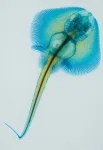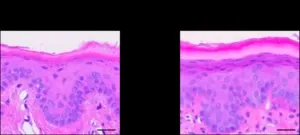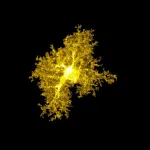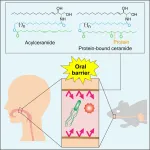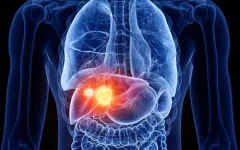(Press-News.org) Rutgers geneticists, working with an international team of scientists, have conducted the most comprehensive sequencing yet of the complete DNA sequence of the little skate – which, like its better-known cousin, the stingray, has long been viewed as enigmatic because of its shape.
The scientists, writing in Nature, reported that by studying the intricacies of Leucoraja erinacea’s genome, they have gained a far better understanding of how the fish evolved from its ancestor – which possessed a much narrower body – over a period of 300 million years to become a flat, winged bottom-dweller.
“We know that animals with a backbone and a skeleton – known as vertebrates – including fish, possess myriad body shapes, but we understand little about the underlying processes controlled by genes,” said Tetsuya Nakamura, an assistant professor in the Department of Genetics in the Rutgers School of Arts and Sciences (SAS) and an author on the study. “In this research, we have identified the genetic mechanisms that create the unique characteristics of the skate body.”
Little skates are an Atlantic Ocean species of skate that are about 16 to 20 inches long. Their flat bodies feature enlarged, wing-like pectoral fins that allow the fish to thrive in sea-floor environments. Their unique shape creates power for rapid forward propulsion. They also use their flat fins to scoop and flip sand over them to hide from predators, covering everything but their eyes.
“We wondered how this unique body evolved during their evolution,” said Nakamura, an expert in evolutionary developmental biology who generally is seeking to understand how humans evolved from fish. “If we came to understand how a skate evolved, perhaps it might give us clues to how other vertebrates developed their shapes.”
In conducting their analysis, the researchers connected the skates’ genotype – their unique sequence of DNA – with their phenotype – their physical properties, from body shape to biochemistry. They also compared the little skate genome with various shark genomes, including that of the bamboo shark, with whom it shares a common ancestor.
The researchers found similarities between the genomes and gene orders of the little skate and the bamboo sharks, which retain ancestral characters of chromosomes, the essential structures compactly packing DNA in the nucleus of every cell.
In the region of the little skate genome that controls for fin development, the researchers found extensive rearrangements in the order of genes, akin to a shuffling of cards. This gene shuffling occurred in the region of fin formation genes in skates when compared to sharks.
In the little skate genomes, researchers also found what they described as a “fin-specific enhancer” for what are known as “Hox” genes, which have been identified in other research to be involved in patterning an animal’s body from head to tail. In vertebrates, Hox genes determine the position of segmentation for areas of the body including the head. In the case of the little skate, the researchers found Hox genes were indispensable for the evolution of its wide fins.
This “extensive conservation of chromosomal identity and gene order, despite 300 million years of divergence,” indicates that most cartilaginous fish like skates, rays and sharks likely share this genetic organization, Nakamura said.
“Overall, we found that genetic recombination and genome sequence changes are critical for skate-wide fin evolution,” he said.
Other Rutgers geneticists involved with the study include Dina Navon, a postdoctoral researcher, and Ali Andrescavage, a lab technician.
END
Scientists sequence genome of little skate, the stingray’s cousin
An international collaboration involving Rutgers researchers unravels the mystery of the fish’s unique shape
2023-04-12
ELSE PRESS RELEASES FROM THIS DATE:
The brain’s support cells may play a key role in OCD
2023-04-12
A type of cell usually characterized as the brain’s support system appears to play an important role in obsessive-compulsive disorder-related behaviors, according to new UCLA Health research published April 12 in Nature.
The new clue about the brain mechanisms behind OCD, a disorder that is incompletely understood, came as a surprise to researchers. They originally sought to study how neurons interact with star-shaped “helper” cells known as astrocytes, which are known to provide support and protection to neurons.
However, ...
Pragmatica-Lung Study, a streamlined model for future cancer clinical trials, begins enrolling patients
2023-04-12
The National Cancer Institute, part of the National Institutes of Health (NIH), has helped launch a phase 3 randomized clinical trial (NCT05633602) of a two-drug combination to treat patients with advanced non-small cell lung cancer (NSCLC). Called the Pragmatica-Lung Study (or S2302), this is one of the first NCI-supported clinical trials to use a trial design that removes many of the barriers that prevent people from joining clinical trials. This “pragmatic” approach aims to increase accessibility ...
Oral barrier is similar in ceramide composition to skin barrier
2023-04-12
Acylceramides and protein-bound ceramides are vital for the formation of the oral barrier in mice, similar to their role in skin, protecting from infection.
The skin is the body’s first line of defense against the environment, particularly against pathogens, chemicals, and allergens. It is now known that a class of biological molecules called acylceramides and their metabolites, protein-bound ceramides, are essential to the formation of this barrier. The outermost tissues of the mouth are closely related to the skin and have similar functions—an oral barrier. However, little ...
How did Earth get its water?
2023-04-12
Washington, DC—Our planet’s water could have originated from interactions between the hydrogen-rich atmospheres and magma oceans of the planetary embryos that comprised Earth’s formative years, according to new work from Carnegie Science’s Anat Shahar and UCLA’s Edward Young and Hilke Schlichting. Their findings, which could explain the origins of Earth’s signature features, are published in Nature.
For decades, what researchers knew about planet formation was based ...
Effect of smartphone app home monitoring after oncologic surgery on quality of recovery
2023-04-12
About The Study: In this randomized clinical trial, postoperative follow-up for patients undergoing breast reconstruction and gynecologic oncology surgery using smartphone app–assisted monitoring led to improved quality of recovery and equal satisfaction with care compared with conventional in-person follow-up.
Authors: Claire Temple-Oberle, M.D., M.Sc., of the University of Calgary in Calgary, Alberta, Canada, is the corresponding author.
To access the embargoed study: Visit our For The Media website at this link https://media.jamanetwork.com/
(doi:10.1001/jamasurg.2023.0616)
Editor’s ...
Taking a placebo improves adherence to treatment for opioid use disorder, study finds
2023-04-12
Substance use disorder affects 20 million Americans, and more than 100,000 people died from a drug overdose in 2021, according to the Centers for Disease Control and Prevention. While the medication methadone has the strongest evidence-based effectiveness to prevent relapse, about half of patients drop out of their treatment within one year of initiation. The solution could lie in taking a simple “sugar pill” or placebo along with the methadone, according to a randomized clinical trial led by researchers at the University of Maryland School of Medicine.
In a randomized ...
New study flips the script on liver cancer
2023-04-12
Liver cancer is the third leading cause of cancer death and the sixth most common cancer type worldwide. Major risk factors include environmental and metabolic stressors, such as obesity, viral hepatitis and steatohepatitis (fatty and inflamed liver).
These stressors damage the liver by killing hepatocytes, the major cell type in the liver. The cell death then triggers an inflammatory response which signals the liver to generate a new batch of hepatocytes. But this sudden push towards cellular proliferation also increases the risk of tumor formation.
In ...
SWOG S2302 Pragmatica-Lung study opens to enrollment, a model for easier, more representative clinical trials
2023-04-12
A clinical trial that breaks new ground with its dramatically streamlined design and unusually broad eligibility criteria is now opening and available to patients with stage 4 or recurrent non-small cell lung cancer at cancer treatment clinics all across the United States.
The S2302 Pragmatica-Lung trial, developed and led by the SWOG Cancer Research Network, a clinical trials group funded by the National Cancer Institute (NCI), is designed to be easier for institutions to open and run and with few limits on eligibility, making it available to a larger group of patients with advanced non-small cell lung ...
Researchers reveal stability origin of Dion-Jacobson 2D perovskites
2023-04-12
Yin-Yang theory is an ancient Chinese philosophy in which Yin-Yang forces are interdependent and work in opposition to each other to create balance.
Recently, inspired by this ancient theory, a research team led by Prof. GUO Xin and Prof. LI Can from the Dalian Institute of Chemical Physics (DICP) of the Chinese Academy of Sciences (CAS) has revealed the origin of the stability of Dion–Jacobson (DJ) phase two-dimensional (2D) perovskite materials.
Their findings were published in Joule on April 12.
DJ 2D perovskites, a class of organic–inorganic ...
Scientists track evolution of microbes on the skin’s surface
2023-04-12
CAMBRIDGE, MA -- Human skin is home to millions of microbes. One of these microbes, Staphylococcus aureus, is an opportunistic pathogen that can invade patches of skin affected by eczema, also known as atopic dermatitis.
In a new study, researchers at MIT and other institutions have discovered that this microbe can rapidly evolve within a single person’s microbiome. They found that in people with eczema, S. aureus tends to evolve to a variant with a mutation in a specific gene that helps it grow faster on the skin.
This study marks ...
LAST 30 PRESS RELEASES:
Tracing the quick synthesis of an industrially important catalyst
New software sheds light on cancer’s hidden genetic networks
UT Health San Antonio awarded $3 million in CPRIT grants to bolster cancer research and prevention efforts in South Texas
Third symposium spotlights global challenge of new contaminants in China’s fight against pollution
From straw to soil harmony: International team reveals how biochar supercharges carbon-smart farming
Myeloma: How AI is redrawing the map of cancer care
Manhattan E. Charurat, Ph.D., MHS invested as the Homer and Martha Gudelsky Distinguished Professor in Medicine at the University of Maryland School of Medicine
Insilico Medicine’s Pharma.AI Q4 Winter Launch Recap: Revolutionizing drug discovery with cutting-edge AI innovations, accelerating the path to pharmaceutical superintelligence
Nanoplastics have diet-dependent impacts on digestive system health
Brain neuron death occurs throughout life and increases with age, a natural human protein drug may halt neuron death in Alzheimer’s disease
SPIE and CLP announce the recipients of the 2025 Advanced Photonics Young Innovator Award
Lessons from the Caldor Fire’s Christmas Valley ‘Miracle’
Ant societies rose by trading individual protection for collective power
Research reveals how ancient viral DNA shapes early embryonic development
A molecular gatekeeper that controls protein synthesis
New ‘cloaking device’ concept to shield sensitive tech from magnetic fields
Researchers show impact of mountain building and climate change on alpine biodiversity
Study models the transition from Neanderthals to modern humans in Europe
University of Phoenix College of Doctoral Studies releases white paper on AI-driven skilling to reduce burnout and restore worker autonomy
AIs fail at the game of visual “telephone”
The levers for a sustainable food system
Potential changes in US homelessness by ending federal support for housing first programs
Vulnerability of large language models to prompt injection when providing medical advice
Researchers develop new system for high-energy-density, long-life, multi-electron transfer bromine-based flow batteries
Ending federal support for housing first programs could increase U.S. homelessness by 5% in one year, new JAMA study finds
New research uncovers molecular ‘safety switch’ shielding cancers from immune attack
Bacteria resisting viral infection can still sink carbon to ocean floor
Younger biological age may increase depression risk in older women during COVID-19
Bharat Innovates 2026 National Basecamp Showcases India’s Most Promising Deep-Tech Ventures
Here’s what determines whether your income level rises or falls
[Press-News.org] Scientists sequence genome of little skate, the stingray’s cousinAn international collaboration involving Rutgers researchers unravels the mystery of the fish’s unique shape
